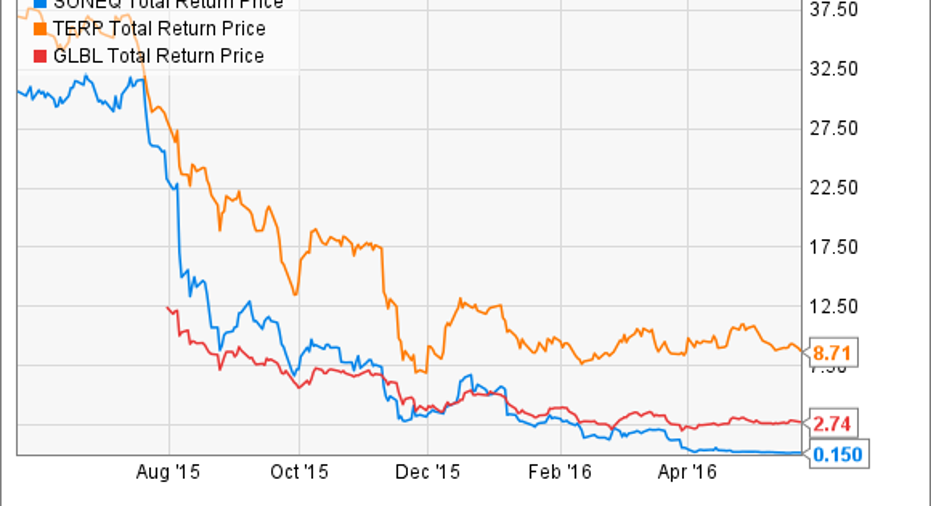How SunEdison's Bankruptcy Impacts TerraForm Power and TerraForm Global

Cloudy skies ahead. Image Soure: Terraform Corporate Presentation
One of North America's largest renewable energy companies, SunEdison,filed for bankruptcy last month, withdebts totaling roughly $16.1 billion. The company's demise -- it onceattracted the interest of major hedge funds, such asDavid Einhorn'sGreenlight Capital, Daniel Loeb'sThird Point Management, andLarry Robbins'Glenview Management -- represents yet another dramatic failure in the solar industry.
The company's fall from grace also casts severe doubts on two of its spin-off companies: Terraform Power (NASDAQ: TERP) and Terraform Global (NASDAQ: GLBL). These sister companies allowedSunEdison to acquire solar and wind assets at a lower cost of capital. Because they shared interests in similar projects, the companies were disproportionately reliant on each other's success.
Now that SunEdison has declared bankruptcy, what does the future hold for Terraform Power and Terraform Global?
SUNEQ Total Return Price data by YCharts
A bit of history
To understand the impact SunEdison's bankruptcy will have on Terraform Power and Terraform Global, we must understand why the companies exist in the first place.
SunEdison was originally a silicon-wafer manufacturer, established in 1959 as the Monsanto Electronic Materials Company. In 1989,Monsanto sold the company, and for decades it was known asMEMC. In 2009, however, the company began a major shift in business strategy, transitioningfrom a panel manufacturer to adeveloper of solar projects, marking its push into independentrenewable power generation.
With its solar project backlog starting to grow, SunEdison was looking for ways to raise increasing amounts of capital at attractive rates, a problem that other solar companies have faced, including SolarCity. So, in2014 and 2015, the company spun-off two companies known as "yieldcos": TerraForm Power and TerraForm Global.
At the time, yieldcos were a fairly novel approach to raising billions in asset-backed financing. The chief purpose of a yieldco is to lower borrowing costs, making projects more attractive compared to those of peers.
Yieldcos lower costs in two ways. First, theybundle renewable, contracted operating assets in order to generate predictable cash flows. By bundling the contracted assets that SunEdison builds, the yieldcos can sell debt at cheaper rates than a single project.Second, theyare structured to simulate the avoided double-taxation benefit of MLPs and REITs, allowing them topass untaxed earnings through to investors.
What's the issue?
The biggest problem facing Terraform Power and Terraform Global is that both companies anticipated recieving a consistent, long-term stream of projects to bundle from SunEdison. With SunEdison's insolvency, the future pipeline of projects is heavily in doubt. According to both companies' latest investor presentation, they will need to "plan for stand-alone capability."
Importantly, however, each company still ownssolar and wind developments, which still have long-term, contracted value even if SunEdison disappears. Both have persistently said that they have"no plans to file for bankruptcy themselves," and the equity interests in their wind and solar power plants are not available to satisfy claims from creditors of SunEdison. Even if they never received another contract, both companies have projects across the globe, with predictable cash flow streams lasting up to 20 years or longer.
Image source: Terraform corporate presentation.
What will the future hold?
Projecting the yieldco's future is incredibly difficult given virtually no clarity on future growth projects. Additionally, without SunEdison's reliable project-sourcing, borrowing costs are rising.For example, Terraform Power just issued debt at an adjustable interest rate of 6.5% or more, significantly higher than the 4% itreceivedin 2015.
Sourcing new projects and keeping debt costs low are the two most important factors for both Terraform Power and Terraform Global. With no visibility on either of those items, an investment decision is all but impossible.
The article How SunEdison's Bankruptcy Impacts TerraForm Power and TerraForm Global originally appeared on Fool.com.
Ryan Vanzo has no position in any stocks mentioned. The Motley Fool owns shares of and recommends SolarCity. Try any of our Foolish newsletter services free for 30 days. We Fools may not all hold the same opinions, but we all believe that considering a diverse range of insights makes us better investors. The Motley Fool has a disclosure policy.
Copyright 1995 - 2016 The Motley Fool, LLC. All rights reserved. The Motley Fool has a disclosure policy.



















